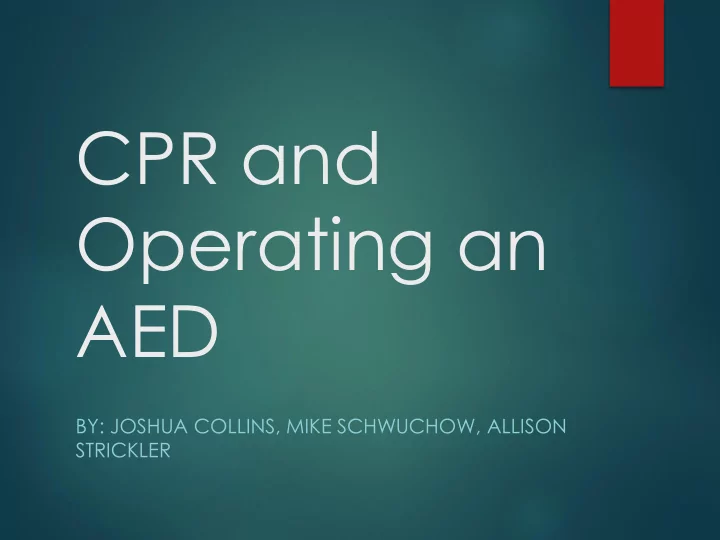

CPR and Operating an AED BY: JOSHUA COLLINS, MIKE SCHWUCHOW, ALLISON STRICKLER
Introduction Cardiopulmonary Resuscitation (CPR) Lifesaving system used in emergencies in which someone’s breathing or heartbeat has ceased Comprises the use of chest compressions and synthetic ventilation to preserve the flow of blood and oxygen during cardiac arrest
Introduction Cont’d Automatic External Defibrillator (AED) Is lightweight, battery-operated, and portable unit Comes with a set of instructions Gives voice prompts
Introduction Cont’d AED Used on an individual who is having sudden cardiac arrest (SCA) Administers an electric shock to reestablish a normal rhythm of the heart
Facts and Figures Many victims 383,000 out-of- appear hospital healthy with sudden no known cardiac arrests heart disease occur or other risk annually. factors CPR provided immediately after 32 percent of sudden cardiac cardiac arrest arrest can double victims get or triple a victim’s CPR from a chance of bystander. survival.
Certification Process The American Heart Association trains more than 12 million people in CPR annually, to equip Americans with the skills they need to perform bystander CPR Certificate valid for 2 years Online and classroom settings Learn how to respond to cardiac and breathing emergencies in adults and children, including the use of automated external defibrillators (AED) CPR/AED Certification available at CoRec Center, Purdue University
CPR in General Use the acronym CAB (Compressions, Airway, Breathing) Providing rescue breaths is no longer required to administer CPR There are three major types of CPR Adult: ages 9 and up Child: ages 1-8 Infant: under one year Keep in mind the size of the person matters
CPR Procedure: Before You Begin 1. Check to see if the person is responsive by tapping them and asking ‘Are you okay?’ 2. If they do not respond, call 911 3. Also obtain an AED. If there is one available, administer one shock before starting CPR
CPR Procedure: C-Compressions Make sure the person is on their back on 1. a flat surface Kneel next to them and place the heel of 2. your hand on their chest (between the nipples). Place your other hand on top of the first Push hard into their chest (about 2 3. inches) Do this 30 times at a rate of 100 4. compressions a minute before giving rescue breaths
CPR Procedure: A-Airway 1. Put your palm on their forehead and gently tilt the head back 2. Use your other hand to tilt the chin forward, opening the airway
CPR Procedure: B-Breathing Put your mouth on the victim’s, 1. creating a seal (not necessary for citizen CPR) Give the first rescue breath and 2. watch to see if their chest rises. If it does not, give the second 3. rescue breath and check for a response before starting the chest compressions again
Adult CPR vs Child/Infant CPR Use the same cycle (30 compressions and 2 breaths) for all age groups but: Use only one hand instead of two when doing CPR on a child and two fingers on an infant Do not press down on the chest as hard Give more gentle breaths (if you chose to give rescue breaths) When using an AED, use the pediatric pads on a child or infant if they are available
When and how to use an AED An AED is used on someone who you believe is suffering sudden cardiac arrest (SCA) The AED is a user-friendly device and will give you verbal and visual instructions
When and How to use an AED https://www.youtube.com/watch?v=NI-P3ysiQSk
How to use an AED Expose the victim’s chest An AED comes with two electrodes that are to be placed on the victim’s chest Place the pads that contain the electrodes on the chest as instructed Make sure everyone is clear and use the AED to deliver the shock when prompted
Conclusion Cardiopulmonary Resuscitation (CPR) A set of steps to be used in any circumstance in which someone’s breathing or heartbeat has ceased Consists of chest compressions and ventilation to maintain blood and oxygen flow during cardiac arrest
Conclusion Cont’d Automatic External Defibrillator (AED) Is light, battery-operated, and portable device Come with Instructions Uses voice prompts to tell the user instructions and when to administer the shock Shock will work on a heart of someone who is having sudden cardiac arrest (SCA) Regenerates a normal rhythm of the heart
Q & A Link to bring to google doc
Post Test Please take 1 – 2 minutes to complete the post test
Recommend
More recommend